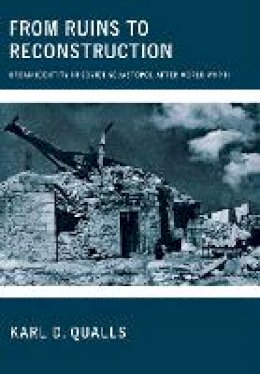
Stock image for illustration purposes only - book cover, edition or condition may vary.
From Ruins to Reconstruction: Urban Identity in Soviet Sevastopol after World War II
Karl D. Qualls
FREE Delivery in Ireland
Description for From Ruins to Reconstruction: Urban Identity in Soviet Sevastopol after World War II
Hardback. Num Pages: 232 pages, 20. BIC Classification: 1DVUA; 3JJPG; HBJD; JFSG. Category: (G) General (US: Trade). Dimension: 229 x 152 x 18. Weight in Grams: 514.
Sevastopol, located in present-day Ukraine but still home to the Russian Black Sea Fleet and revered by Russians for its role in the Crimean War, was utterly destroyed by German forces during World War II. In From Ruins to Reconstruction, Karl D. Qualls tells the complex story of the city's rebuilding. Based on extensive research in archives in both Moscow and Sevastopol, architectural plans and drawings, interviews, and his own extensive experience in Sevastopol, Qualls tells a unique story in which the periphery "bests" the Stalinist center: the city's experience shows that local officials had considerable room to maneuver even ... Read moreduring the peak years of Stalinist control.
Qualls first paints a vivid portrait of the ruined city and the sufferings of its surviving inhabitants. He then turns to Moscow's plans to remake the ancient city on the heroic socialist model prized by Stalin and visited upon most other postwar Soviet cities and towns. In Sevastopol, however, the architects and city planners sent out from the center "went native," deviating from Moscow's blueprints to collaborate with local officials and residents, who seized control of the planning process and rebuilt the city in a manner that celebrated its distinctive historical identity.
When completed, postwar Sevastopol resembled a nineteenth-century Russian city, with tree-lined boulevards; wide walkways; and buildings, street names, and memorials to its heroism in wars both long past and recent. Though visually Russian (and still containing a majority Russian-speaking population), Sevastopol was in 1954 joined to Ukraine, which in 1991 became an independent state. In his concluding chapter, Qualls explores how the "Russianness" of the city and the presence of the Russian fleet affect relations between Ukraine, Russia, and the West.
Show Less
Product Details
Publisher
Cornell University Press United States
Place of Publication
Ithaca, United States
Shipping Time
Usually ships in 7 to 11 working days
About Karl D. Qualls
Karl D. Qualls is Associate Professor of History at Dickinson College.
Reviews for From Ruins to Reconstruction: Urban Identity in Soviet Sevastopol after World War II
"Overwhelmingly destroyed during World War II, the city of Sevastopol was celebrated in the Soviet period as a 'hero city' that valiantly resisted the Nazis. The epic of Sevastopol's destruction, reconstruction, and memorializing as recounted in Karl D. Qualls's From Ruins to Reconstruction is both an important case study of postwar reconstruction and a significant contribution to our understanding of ... Read more'high Stalinism.' The rebuilding of the shattered city and memorializing its heroic past (both in World War II and earlier), as Qualls convincingly argues, reveals a complicated interplay between local actors and Moscow, both in creating the postwar period and determining how the resurrected Sevastopol should be remembered."
Theodore R. Weeks, Southern Illinois University, author of From Assimilation to Antisemitism "Scholars finally have begun telling the story of rebuilding bombed cities in the former Soviet Union, and with this solidly researched, well-written book, Karl D. Qualls is leading the way. Sensitive to the nuances of both Soviet and local politics and the distinctive cultural features of Sevastopol, Qualls argues that rebuilding Sevastopol was a classic center-periphery contest, with local initiatives on both urban planning and architectural style prevailing over policies coming from Moscow. The result was more a recreation of the nineteenth-century city than a creation of a city along Stalinist lines."
Jeffry Diefendorf, Pamela Shulman Professor of European and Holocaust Studies and Professor of History, University of New Hampshire, author of In the Wake of War "The rebuilding of Sevastopol involved negotiation between a central vision and on-the-spot realities and aspirations. Karl D. Qualls reveals in detail not only the contest of authority over the design and execution of the rebuilding project but also the difficulties encountered in the shortage of workers and materials. Qualls demonstrates that the inhabitants preferred to show a historic heroic, military, naval, and emphatically Russian face to the world, rather than a strictly Soviet facade. It is this very Russian city, housing both the Russian and the Ukrainian Black Sea fleets that is a source of friction between Russia and Ukraine today. In exploring important issues of image and identity, Qualls has made admirable use of archives, newsreels, films, and interviews."
Patricia Herlihy, Brown University, author of The Alcoholic Empire Show Less

